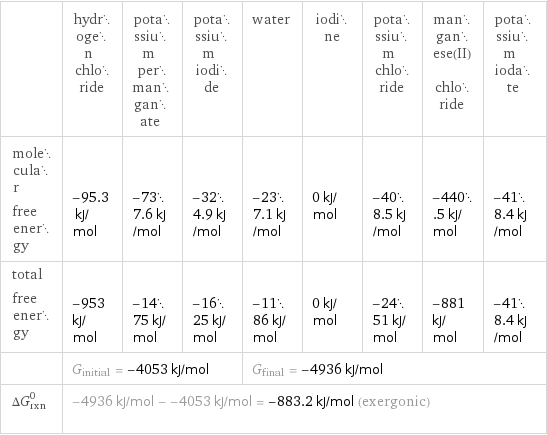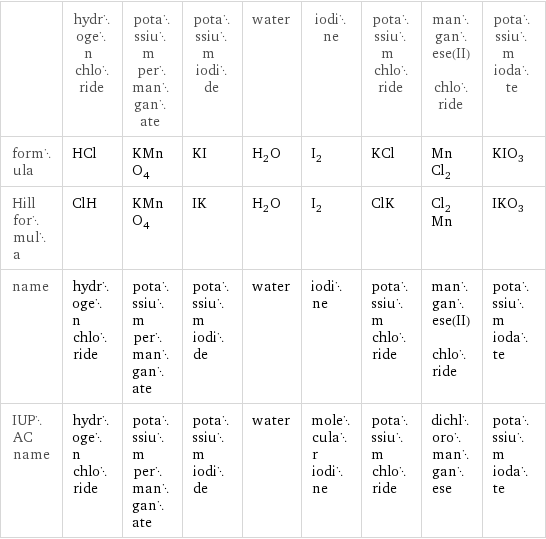Input interpretation

HCl hydrogen chloride + KMnO_4 potassium permanganate + KI potassium iodide ⟶ H_2O water + I_2 iodine + KCl potassium chloride + MnCl_2 manganese(II) chloride + KIO_3 potassium iodate
Balanced equation

Balance the chemical equation algebraically: HCl + KMnO_4 + KI ⟶ H_2O + I_2 + KCl + MnCl_2 + KIO_3 Add stoichiometric coefficients, c_i, to the reactants and products: c_1 HCl + c_2 KMnO_4 + c_3 KI ⟶ c_4 H_2O + c_5 I_2 + c_6 KCl + c_7 MnCl_2 + c_8 KIO_3 Set the number of atoms in the reactants equal to the number of atoms in the products for Cl, H, K, Mn, O and I: Cl: | c_1 = c_6 + 2 c_7 H: | c_1 = 2 c_4 K: | c_2 + c_3 = c_6 + c_8 Mn: | c_2 = c_7 O: | 4 c_2 = c_4 + 3 c_8 I: | c_3 = 2 c_5 + c_8 Since the coefficients are relative quantities and underdetermined, choose a coefficient to set arbitrarily. To keep the coefficients small, the arbitrary value is ordinarily one. For instance, set c_8 = 1 and solve the system of equations for the remaining coefficients: c_2 = c_1/8 + 3/4 c_3 = (5 c_1)/8 - 5/4 c_4 = c_1/2 c_5 = (5 c_1)/16 - 9/8 c_6 = (3 c_1)/4 - 3/2 c_7 = c_1/8 + 3/4 c_8 = 1 The resulting system of equations is still underdetermined, so an additional coefficient must be set arbitrarily. Set c_1 = 10 and solve for the remaining coefficients: c_1 = 10 c_2 = 2 c_3 = 5 c_4 = 5 c_5 = 2 c_6 = 6 c_7 = 2 c_8 = 1 Substitute the coefficients into the chemical reaction to obtain the balanced equation: Answer: | | 10 HCl + 2 KMnO_4 + 5 KI ⟶ 5 H_2O + 2 I_2 + 6 KCl + 2 MnCl_2 + KIO_3
Structures

+ + ⟶ + + + +
Names

hydrogen chloride + potassium permanganate + potassium iodide ⟶ water + iodine + potassium chloride + manganese(II) chloride + potassium iodate
Reaction thermodynamics
Gibbs free energy

| hydrogen chloride | potassium permanganate | potassium iodide | water | iodine | potassium chloride | manganese(II) chloride | potassium iodate molecular free energy | -95.3 kJ/mol | -737.6 kJ/mol | -324.9 kJ/mol | -237.1 kJ/mol | 0 kJ/mol | -408.5 kJ/mol | -440.5 kJ/mol | -418.4 kJ/mol total free energy | -953 kJ/mol | -1475 kJ/mol | -1625 kJ/mol | -1186 kJ/mol | 0 kJ/mol | -2451 kJ/mol | -881 kJ/mol | -418.4 kJ/mol | G_initial = -4053 kJ/mol | | | G_final = -4936 kJ/mol | | | | ΔG_rxn^0 | -4936 kJ/mol - -4053 kJ/mol = -883.2 kJ/mol (exergonic) | | | | | | |
Equilibrium constant
![Construct the equilibrium constant, K, expression for: HCl + KMnO_4 + KI ⟶ H_2O + I_2 + KCl + MnCl_2 + KIO_3 Plan: • Balance the chemical equation. • Determine the stoichiometric numbers. • Assemble the activity expression for each chemical species. • Use the activity expressions to build the equilibrium constant expression. Write the balanced chemical equation: 10 HCl + 2 KMnO_4 + 5 KI ⟶ 5 H_2O + 2 I_2 + 6 KCl + 2 MnCl_2 + KIO_3 Assign stoichiometric numbers, ν_i, using the stoichiometric coefficients, c_i, from the balanced chemical equation in the following manner: ν_i = -c_i for reactants and ν_i = c_i for products: chemical species | c_i | ν_i HCl | 10 | -10 KMnO_4 | 2 | -2 KI | 5 | -5 H_2O | 5 | 5 I_2 | 2 | 2 KCl | 6 | 6 MnCl_2 | 2 | 2 KIO_3 | 1 | 1 Assemble the activity expressions accounting for the state of matter and ν_i: chemical species | c_i | ν_i | activity expression HCl | 10 | -10 | ([HCl])^(-10) KMnO_4 | 2 | -2 | ([KMnO4])^(-2) KI | 5 | -5 | ([KI])^(-5) H_2O | 5 | 5 | ([H2O])^5 I_2 | 2 | 2 | ([I2])^2 KCl | 6 | 6 | ([KCl])^6 MnCl_2 | 2 | 2 | ([MnCl2])^2 KIO_3 | 1 | 1 | [KIO3] The equilibrium constant symbol in the concentration basis is: K_c Mulitply the activity expressions to arrive at the K_c expression: Answer: | | K_c = ([HCl])^(-10) ([KMnO4])^(-2) ([KI])^(-5) ([H2O])^5 ([I2])^2 ([KCl])^6 ([MnCl2])^2 [KIO3] = (([H2O])^5 ([I2])^2 ([KCl])^6 ([MnCl2])^2 [KIO3])/(([HCl])^10 ([KMnO4])^2 ([KI])^5)](../image_source/9a2d822de1b39495501d1a0521976e58.png)
Construct the equilibrium constant, K, expression for: HCl + KMnO_4 + KI ⟶ H_2O + I_2 + KCl + MnCl_2 + KIO_3 Plan: • Balance the chemical equation. • Determine the stoichiometric numbers. • Assemble the activity expression for each chemical species. • Use the activity expressions to build the equilibrium constant expression. Write the balanced chemical equation: 10 HCl + 2 KMnO_4 + 5 KI ⟶ 5 H_2O + 2 I_2 + 6 KCl + 2 MnCl_2 + KIO_3 Assign stoichiometric numbers, ν_i, using the stoichiometric coefficients, c_i, from the balanced chemical equation in the following manner: ν_i = -c_i for reactants and ν_i = c_i for products: chemical species | c_i | ν_i HCl | 10 | -10 KMnO_4 | 2 | -2 KI | 5 | -5 H_2O | 5 | 5 I_2 | 2 | 2 KCl | 6 | 6 MnCl_2 | 2 | 2 KIO_3 | 1 | 1 Assemble the activity expressions accounting for the state of matter and ν_i: chemical species | c_i | ν_i | activity expression HCl | 10 | -10 | ([HCl])^(-10) KMnO_4 | 2 | -2 | ([KMnO4])^(-2) KI | 5 | -5 | ([KI])^(-5) H_2O | 5 | 5 | ([H2O])^5 I_2 | 2 | 2 | ([I2])^2 KCl | 6 | 6 | ([KCl])^6 MnCl_2 | 2 | 2 | ([MnCl2])^2 KIO_3 | 1 | 1 | [KIO3] The equilibrium constant symbol in the concentration basis is: K_c Mulitply the activity expressions to arrive at the K_c expression: Answer: | | K_c = ([HCl])^(-10) ([KMnO4])^(-2) ([KI])^(-5) ([H2O])^5 ([I2])^2 ([KCl])^6 ([MnCl2])^2 [KIO3] = (([H2O])^5 ([I2])^2 ([KCl])^6 ([MnCl2])^2 [KIO3])/(([HCl])^10 ([KMnO4])^2 ([KI])^5)
Rate of reaction
![Construct the rate of reaction expression for: HCl + KMnO_4 + KI ⟶ H_2O + I_2 + KCl + MnCl_2 + KIO_3 Plan: • Balance the chemical equation. • Determine the stoichiometric numbers. • Assemble the rate term for each chemical species. • Write the rate of reaction expression. Write the balanced chemical equation: 10 HCl + 2 KMnO_4 + 5 KI ⟶ 5 H_2O + 2 I_2 + 6 KCl + 2 MnCl_2 + KIO_3 Assign stoichiometric numbers, ν_i, using the stoichiometric coefficients, c_i, from the balanced chemical equation in the following manner: ν_i = -c_i for reactants and ν_i = c_i for products: chemical species | c_i | ν_i HCl | 10 | -10 KMnO_4 | 2 | -2 KI | 5 | -5 H_2O | 5 | 5 I_2 | 2 | 2 KCl | 6 | 6 MnCl_2 | 2 | 2 KIO_3 | 1 | 1 The rate term for each chemical species, B_i, is 1/ν_i(Δ[B_i])/(Δt) where [B_i] is the amount concentration and t is time: chemical species | c_i | ν_i | rate term HCl | 10 | -10 | -1/10 (Δ[HCl])/(Δt) KMnO_4 | 2 | -2 | -1/2 (Δ[KMnO4])/(Δt) KI | 5 | -5 | -1/5 (Δ[KI])/(Δt) H_2O | 5 | 5 | 1/5 (Δ[H2O])/(Δt) I_2 | 2 | 2 | 1/2 (Δ[I2])/(Δt) KCl | 6 | 6 | 1/6 (Δ[KCl])/(Δt) MnCl_2 | 2 | 2 | 1/2 (Δ[MnCl2])/(Δt) KIO_3 | 1 | 1 | (Δ[KIO3])/(Δt) (for infinitesimal rate of change, replace Δ with d) Set the rate terms equal to each other to arrive at the rate expression: Answer: | | rate = -1/10 (Δ[HCl])/(Δt) = -1/2 (Δ[KMnO4])/(Δt) = -1/5 (Δ[KI])/(Δt) = 1/5 (Δ[H2O])/(Δt) = 1/2 (Δ[I2])/(Δt) = 1/6 (Δ[KCl])/(Δt) = 1/2 (Δ[MnCl2])/(Δt) = (Δ[KIO3])/(Δt) (assuming constant volume and no accumulation of intermediates or side products)](../image_source/5dc6b27cfe93472b016ee4d912e80e13.png)
Construct the rate of reaction expression for: HCl + KMnO_4 + KI ⟶ H_2O + I_2 + KCl + MnCl_2 + KIO_3 Plan: • Balance the chemical equation. • Determine the stoichiometric numbers. • Assemble the rate term for each chemical species. • Write the rate of reaction expression. Write the balanced chemical equation: 10 HCl + 2 KMnO_4 + 5 KI ⟶ 5 H_2O + 2 I_2 + 6 KCl + 2 MnCl_2 + KIO_3 Assign stoichiometric numbers, ν_i, using the stoichiometric coefficients, c_i, from the balanced chemical equation in the following manner: ν_i = -c_i for reactants and ν_i = c_i for products: chemical species | c_i | ν_i HCl | 10 | -10 KMnO_4 | 2 | -2 KI | 5 | -5 H_2O | 5 | 5 I_2 | 2 | 2 KCl | 6 | 6 MnCl_2 | 2 | 2 KIO_3 | 1 | 1 The rate term for each chemical species, B_i, is 1/ν_i(Δ[B_i])/(Δt) where [B_i] is the amount concentration and t is time: chemical species | c_i | ν_i | rate term HCl | 10 | -10 | -1/10 (Δ[HCl])/(Δt) KMnO_4 | 2 | -2 | -1/2 (Δ[KMnO4])/(Δt) KI | 5 | -5 | -1/5 (Δ[KI])/(Δt) H_2O | 5 | 5 | 1/5 (Δ[H2O])/(Δt) I_2 | 2 | 2 | 1/2 (Δ[I2])/(Δt) KCl | 6 | 6 | 1/6 (Δ[KCl])/(Δt) MnCl_2 | 2 | 2 | 1/2 (Δ[MnCl2])/(Δt) KIO_3 | 1 | 1 | (Δ[KIO3])/(Δt) (for infinitesimal rate of change, replace Δ with d) Set the rate terms equal to each other to arrive at the rate expression: Answer: | | rate = -1/10 (Δ[HCl])/(Δt) = -1/2 (Δ[KMnO4])/(Δt) = -1/5 (Δ[KI])/(Δt) = 1/5 (Δ[H2O])/(Δt) = 1/2 (Δ[I2])/(Δt) = 1/6 (Δ[KCl])/(Δt) = 1/2 (Δ[MnCl2])/(Δt) = (Δ[KIO3])/(Δt) (assuming constant volume and no accumulation of intermediates or side products)
Chemical names and formulas

| hydrogen chloride | potassium permanganate | potassium iodide | water | iodine | potassium chloride | manganese(II) chloride | potassium iodate formula | HCl | KMnO_4 | KI | H_2O | I_2 | KCl | MnCl_2 | KIO_3 Hill formula | ClH | KMnO_4 | IK | H_2O | I_2 | ClK | Cl_2Mn | IKO_3 name | hydrogen chloride | potassium permanganate | potassium iodide | water | iodine | potassium chloride | manganese(II) chloride | potassium iodate IUPAC name | hydrogen chloride | potassium permanganate | potassium iodide | water | molecular iodine | potassium chloride | dichloromanganese | potassium iodate